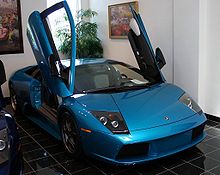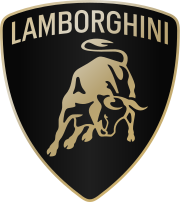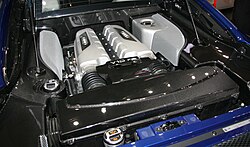Lamborghini
From Wikipedia, the free encyclopedia
Automobili Lamborghini S.p.A.,
[Notes 1] commonly referred to as
Lamborghini (
Italian: [lamborˈɡiːni] ( listen)
listen)), is an Italian
car manufacturer. The company was founded by manufacturing magnate
Ferruccio Lamborghini in 1963, with the objective of producing a refined
grand touring car to compete with established offerings from marques like
Ferrari.
The company's first models were released in the mid-1960s, and were
noted for their refinement, power and comfort. Lamborghini gained wide
acclaim in 1966 for the
Miura sports coupé, which established
mid-engine design
as the standard layout for high-performance cars of the era. After a
decade of rapid growth, hard times befell the company in the mid-1970s,
as sales plunged in the wake of the
1973 world financial downturn and
oil crisis. After going through bankruptcy and three changes in ownership, Lamborghini came under the corporate umbrella of the
Chrysler Corporation
in 1987. The American company failed to return the automaker to
profitability and sold it to Indonesian interests in 1994. Lamborghini's
lack of success continued through the 1990s, until the company was sold
in 1998 to
Audi, a subsidiary of the
Volkswagen Group (a German automotive
concern).
Audi's ownership marked the beginning of a period of stability and
increased productivity for Lamborghini, with sales increasing nearly
tenfold over the course of the 2000s, peaking in record sales in 2007
and 2008. The
world financial crisis in the late 2000s negatively affected luxury car makers worldwide, and saw Lamborghini's sales drop back to pre-2006 levels.
Assembly of Lamborghini cars continues to take place at the
automaker's ancestral home in Sant'Agata Bolognese, where engine and
automobile production lines run side-by-side at the company's single
factory. Fewer than 3,000 cars roll off the production line each year.
The
flagship V12-powered Murciélago coupé and roadster were discontinued at the end of 2010. Its successor, the
Lamborghini Aventador, was released on 28 February 2011.
Lamborghini Murciélago
From Wikipedia, the free encyclopedia
Lamborghini Murciélago
 |
| Manufacturer |
Lamborghini |
| Production |
2001-2010
4,099 built[1] |
| Assembly |
Sant'Agata Bolognese, Italy |
| Predecessor |
Lamborghini Diablo |
| Successor |
Lamborghini Aventador |
| Class |
Sports car |
| Body style |
2-door coupé
2-door roadster |
| Layout |
Mid-engine, four-wheel drive |
| Engine |
6.2 L V12
6.5 L V12 |
| Transmission |
6-speed manual
6-speed e-Gear semi-automatic |
| Wheelbase |
2,665 mm (104.9 in) |
| Length |
2002-06: 4,580 mm (180.3 in)
2007-10: 4,610 mm (181.5 in) |
| Width |
2002-06: 2,045 mm (80.5 in)
2007-10: 2,057 mm (81.0 in) |
| Height |
1,135 mm (44.7 in) |
| Curb weight |
Dry weight:
1,650 kg (3,638 lb)
1,665 kg (3,671 lb) LP640
1,565 kg (3,450 lb) LP670-4 SV |
| Related |
Lamborghini Reventón |
| Designer |
Luc Donckerwolke |
The
Lamborghini Murciélago is a two-door, two-seat
sports car produced by Italian automaker
Lamborghini between 2001
[2] and 2010. Successor to the
Diablo and
flagship of the automaker's
lineup, the Murciélago was introduced as a
coupé
in 2001. The automaker's first new design in eleven years, the car was
also the brand's first new model under the ownership of German parent
company
Audi. It was styled by
Peruvian-born
Belgian Luc Donckerwolke, Lamborghini's head of design from 1998 to 2005.
[3]
A
roadster
version was introduced in 2004, followed by the updated LP 640 coupé
and roadster and limited edition LP 650-4 Roadster. The final variation
to wear the Murciélago
nameplate was the LP 670-4 SuperVeloce, powered by the largest and final evolution of the historic
Lamborghini V12 engine. Production of the Murciélago ended on November 5, 2010, with a total run of 4,099 cars.
[4] Its successor, the
Aventador, was released at the
2011 Geneva Motor Show.
[5]
First generation
[edit] Murcielago

The 6.2-liter V12 from a first-generation Murciélago
The Murciélago is an
all-wheel drive,
mid-engined
supersports car. With an angular design and an exceptionally low slung
body, the highest point of the roof is just under 4 feet above the
ground. One of the vehicle's most distinguishing features are its
scissor doors. which lends to the extreme image. First-generation Murciélagos, produced between 2001 and 2010, were powered by a
Lamborghini V12 which traces its roots back to the company's beginnings in the 1960s. The rear
differential
is integrated to the engine itself, with a viscous coupling center
differential providing drive to the front wheels. Power is delivered
through a 6-speed manual transmission. The Murciélago suspension uses an
independent double-wishbone design, and bodywork features carbon fiber,
steel and aluminum parts. The rear spoiler and the active air intakes
integrated into the car's shoulders are electromechanically controlled,
deploying automatically only at high speeds in an effort to maximize
both aerodynamic and cooling efficiency.
The first generation cars were produced between 2001 and 2006, and
known simply as Murciélago, sometimes Murciélago VT. Their V12 engines
produced just under 580 PS, or
Pferdestärke (
German:
horse strength), a European unit to measure horsepower, and powered the car to 100 km/h (62 mph) in 3.8 seconds.
[6]
Subsequent versions incorporated an alphanumeric designation to the
name Murciélago, which indicated their engine configuration and output.
However, the original cars are never referred to as "LP 580s".
[edit] Murcielago Roadster
The Murciélago
Roadster
was introduced in 2004. Primarily designed to be an open top car, it
employed a manually-attached soft roof as cover from adverse weather,
but a warning on the windshield header advises the driver not to exceed
100 mph (160 km/h) with the top in place.
[3] Designer Donckerwolke cited the
B-2 stealth bomber, the Wally
118 WallyPower yacht, and architect Santiago Calatrava's
Ciutat de les Arts i les Ciències in
Valencia,
Spain as his inspiration for the roadster's revised rear pillars and engine cover.
[3]
[edit] Second Generation
[edit] Murcielago LP640

A Murciélago LP 640 coupé
In March 2006, Lamborghini unveiled a new version of its halo car at the
Geneva Motor Show:
the Murciélago LP 640. The new title incorporated the car's name, along
with an alphanumeric designation which indicated the engine's
orientation (
Longitudinale Posteriore), along with the newly
updated power output. With displacement now increased to 6.5 liters, the
new car made 640 PS (471 kW; 631 hp) at 8000 rpm. The Murciélago's
exterior received a minor
facelift.
Front and rear fascias were revised, and side air intakes were now
asymmetrical with the left side feeding an oil cooler. A new single
outlet exhaust system incorporated into the rear diffuser, modified
suspension tuning, revised programming and upgraded clutch for the
6-speed "e-Gear" automated sequential transmission with
launch control
rounded out the performance modifications. Interior seating was also
re-shaped to provide greater headroom, and a new stereo system formed
part of the updated
dashboard. In the U.S.
MSRP was set at
$318,800.
[citation needed] Optional equipment included
Carbon fibre-reinforced Silicon Carbide (C/SiC)
ceramic composite
brakes, chrome
paddle shifters and a glass engine cover. The 2008 car's estimated
fuel economy for the 6-speed manual is 8 miles per U.S. gallon (29 L/100 km; 9.6 mpg
-imp) city and 13 miles per U.S. gallon (18 L/100 km; 16 mpg
-imp) freeway, making it the least efficient car in 2008 for city and highway driving, according to the
EPA.
[7]
[edit] Murcielago LP640 Roadster

A Murciélago LP 640 roadster
At the 2006
Los Angeles Auto Show, Lamborghini announced that the roadster version of the Murciélago will also be updated to LP 640 status.
[8]
[edit] Murcielago LP670-4 SuperVeloce

A Lamborghini Murciélago LP 670-4 SuperVeloce
At the 2009
Geneva Motor Show,
Lamborghini unveiled the ultimate version of the Murciélago, the LP 670-4 SuperVeloce.
[9] The SV moniker had previously appeared on the
Diablo SV, and
Miura. SV variants are more extreme and track-orientated, and are released at the end of each model's production run.
[10]
The SuperVeloce's V12 produces 670 PS (493 kW; 661 hp) at 8000 rpm
and 490 lb·ft (660 N·m) of torque at 6500 rpm, thanks to revised
valve timing and upgraded intake system. The car's weight was also reduced by 220 lb (100 kg) through extensive use of
carbon fiber inside and out. A new lighter
exhaust system
was also used. As a result of the extensive weight loss, the SV
produces a power-to-weight ratio of 429 Bhp/long ton. Also standard were
the LP 640's optional 15-inch carbon-ceramic disc brakes with 6 piston
calipers. In its June 2009 issue,
Car and Driver
magazine estimated that the LP 670-4 SV was capable of accelerating to
62 mph (100 km/h) from a standing start in just 2.9 seconds and on to
124 mph (200 km/h) in 7.4 seconds. Subsequent testing by "Road and
Track" revealed a 0-60 time of 2.8 seconds and a quarter mile time of
10.9 seconds at 129.4 miles per hour.
[11] Lamborghini claims a top speed of 213 mph (343 km/h) when the car is fitted with an optional smaller
spoiler, or 209 mph (336 km/h) with the standard Aeropack wing.
[12]
According to
Maurizio Reggiani, head of Lamborghini
R&D,
the LP 670-4 SV's steering was tuned for high-speed sensitivity.
Production of the ultimate Murciélago was limited to 350 cars, and cost
$450,000 (approximately
£270,038 in 2009).
In April 2010, Lamborghini released a variant of the LP 670-4 called
the SuperVeloce China Limited Edition. The car was offered for sale
exclusively in China (with 12 retail outlets, China overtook Italy as
Lamborghini's 2nd largest market after the USA), and is distinguished by
special exterior markings.
[13]
[edit] Limited Editions
[edit] 40th Anniversary Edition

Lamborghini Murciélago 40th Anniversary Edition
In 2004, Lamborghini celebrated its 40th
anniversary
by releasing a limited run of 50 40th-Anniversary Edition Murciélagos.
Enhancements over the standard vehicle included a limited-edition blue
body color that was labeled "Jade-Green", carbon-fiber exterior
detailing, upgraded wheels, a revamped exhaust system, and a numbered
plaque on the inside of the rear window. The interior also featured unique leather trim.
[14]
[edit] LP 640 Versace
The Murciélago LP 640
Versace is a special limited edition of the LP 640 that was unveiled at the
2006 Paris Motor Show.
Available in either white or black, only 20 were produced as both
coupés and roadsters. Although the standard V12 engine was used,
stylists from the Versace fashion house, and Lamborghini's Ad Personam
program, collaborated to design custom interiors finished in two-toned
Versace leather.
Gianni Versace logo plaque.
[15]
Each unit came with matching Versace luggage, along with driving shoes,
and gloves. A matching watch from Versace's Precious Items department
was also made available to customers.
[16]
[edit] LP 650-4 Roadster
In 2009, Lamborghini released a limited-run update of the Murciélago
Roadster. The LP 650-4's increased engine output was rated at 650 PS
(478 kW; 641 hp) and 490 lb·ft (660 N·m), allowing the car to reach
62 mph (100 km/h) in 3.4 seconds and achieve a top speed of 205 mph
(330 km/h). Only available in
Grigio Telesto gray with
Arancio orange highlights, the color scheme was continued on the inside.
[17]
[edit] Specifications
[edit] Engines
| Model |
Engine |
Power, Torque@rpm |
Acceleration (seconds) |
Top Speed |
| 0-60 mph |
0-100 mph |
0-150 mph |
Quarter Mile |
| Murciélago (2001–2005)[18] |
6.2 L V12 |
580 PS (427 kW; 572 hp), 649 N·m (479 lb·ft) |
3.5 |
8.3 |
21.4 |
11.7@122 mph |
official: 205 mph
(330 km/h)
|
| Murciélago LP 640[19] |
6,496 cc (6.496 L; 396.4 cu in) V12 |
640 PS (471 kW; 631 hp)@8000rpm, 490 lb·ft (660 N·m)@6000rpm |
3.3 |
7.5 |
-- |
11.2@127 mph |
official: 211 mph
(340 km/h)
|
| Murciélago LP 640 Roadster[20] |
3.4 |
8.1 |
16.1 |
11.8@126 mph (203 km/h) (C&D) |
official: 205 mph
(330 km/h)
|
| Murciélago LP 650-4 Roadster[21] |
650 PS (478 kW; 641 hp), 490 lb·ft (660 N·m) |
3.4 |
- |
- |
- |
official: 205 mph
(330 km/h)
|
| Murciélago LP 670-4 SuperVeloce |
670 PS (493 kW; 661 hp)@8000rpm, 490 lb·ft (660 N·m)@6500rpm |
3.2[22] |
- |
- |
10.9@130.4 (R&T) |
official: 212 mph
(342 km/h),
209 mph (337 km/h) with Aeropack Wing
|
[edit] Transmissions
| Model |
Standard |
Optional |
| Murciélago, Murciélago LP 640, Murciélago LP 670-4 SuperVeloce |
6-speed manual |
6-speed e-Gear |
[edit] Safety recall
In May 2010 in the United States, Lamborghini recalled 428 of its
2007–2008 Murciélago coupés and roadsters because of the possibility of
weld failure on the fuel pump support inside the fuel tank, potentially
leading to a fuel leak and possible fire.
[23][24]
[edit] Motorsport

Reiter Engineering's Murciélago R-GT, campaigned under the
InterProgress Bank Spartak Racing name
The Lamborghini Murciélago R-GT is the racing version of the Murciélago, developed jointly with
Reiter Engineering
and Audi Sport. Unlike the standard car, the R-GT is rear-wheel drive
only and only 9 were produced, in order to comply with the
FIA,
ACO, and JAF rules. The car retains the standard V12 engine, but
air restrictors
are used to manage power. Acceleration and top speed performance are
dependent on gearing, as different ratios are used for different tracks.
In March 2007, the All-Inkl.com Racing Murciélago won the
Zhuhai 2 Hours.
In April 2009, beating a Corvette C6-R, and Saleen S7-R, a Murciélago
R-GT of the Russian IPB Spartak Racing Team won the GT1 class in the
1000 km de Catalunya, a
LMS race. The drivers of the IPB Spartak Racing car were Russian,
Roman Rusinov, and Dutch,
Peter Kox.
The Lamborghini made pole position, but was moved to the end of the
grid due to some technical irregularities. They finished 2 laps ahead of
the lead Corvette to take the second international win for a Ragin'
Bull GT car.
[edit] RG-1 (2004-)
A version of the R-GT built for the Japanese Lamborghini Owners Club to compete in Japanese
Super GT series (JLOC).
[25] In March 2006, an RG-1 recorded the first victory ever for a Lamborghini when they earned a win in the GT300 class at the
Super GT Suzuka 500 km.
An evolution of the R-GT developed by
Reiter Engineering to comply with the
FIA rules for the new
FIA GT1 World Championship. The
2010 FIA GT1 World Championship season saw Reiter run two cars and the other two were run by
All-Inkl.com Münnich Motorsport.
Reiter saw some success winning two Championship races finishing third
in the teams championship. The All-Inkl team did not have as much
success finishing ninth in the championship. The
2011 season saw
Swiss Racing Team run the ex-Reiter R-SV's, after an unsuccessful season in 2010 running
Nissan GT-R's.
All-Inkl have had a successful season so far topping the teams
championship as of round seven. Swiss Racing Team had some points
finishes but after a crash between both cars at the
Sachsenring round,
they had a lack of spare parts and did not compete in the next three
events. DKR Engineering announced that they would be using Murcielago
R-SVs for the last 2 rounds of the season, instead of the
Chevrolet Corvette C6.R that they were using for the first 8 rounds.Its top speed is 402 km / h.
[edit] Related development

The 2006 Miura Concept was based on a Murciélago chassis
[edit] Lamborghini Miura concept
In January 2006, a
retro-styled Lamborghini Miura concept car, built of a Murciélago chassis, was announced at the
Museum of Television & Radio and promoted at the
Los Angeles Auto Show, although the car itself was not present at the show. Subsequently, Miura concept was officially debuted at the
North American International Auto Show just two weeks later. It was the first design penned by Lamborghini design chief,
Walter de'Silva, and commemorated the 40th anniversary of the 1966 introduction of the original Miura in Geneva.
Lamborghini president and CEO, Stefan Winkelmann, rejected any
possibility of the concept marking the Miura's return to production
however, stating “The Miura was a celebration of our history, but
Lamborghini is about the future. Retro design is not what we are here
for. So we won’t do the Miura.”
[26]

The rare Lamborghini Reventón
[edit] Lamborghini Reventón
Debuted in 2007 at the
Frankfurt Auto Show,
[27]
the Lamborghini Reventón is a modified version of the Murciélago. The
car's mechanical underpinnings and engine are identical to those of the
Murciélago LP 640. However, the cosmetics are all unique. Interior and
exterior styling were inspired by stealth fighter design, taking cues
from aircraft such as the
F-22 Raptor.
Only 21 units were built, of which one was retained by the factory to
be exhibited in the Lamborghini museum. Lamborghini also produced 15
units of a roadster version.
[edit] Lamborghini Aventador
The development of a successor to the Murciélago was widely
speculated in the motoring press as the supercar approached the end of
its first
decade
in production. Spy photos published on the internet in January 2010
showed a camouflaged Lamborghini prototype undergoing winter testing.
[28] In December 2010,
Autocar
published a test drive of the new prototype, however, very little was
released. Even the name was a mystery up until it was reported that
Lamborghini registered the name "Aventador" with the
U.S. trademark office.
[29]
At the
2011 Geneva Motor Show, Lamborghini revealed their new
V12 flagship and Murciélago successor, the Aventador LP 700-4. The new
super car
utilizes a brand new 6.5 liter V12 engine producing 691 hp (700 PS;
515 kW). 0–62 mph (100 km/h) takes but a claimed 2.9 seconds. Top speed
has been stated to exceed 217 mph (350 km/h). The Aventador will also be
considerably lighter than the outgoing Murciélago, with a dry weight of
just 3,472 lb (1,575 kg). The price of is expected to be around
$380,000 (€260,000).
[30]\
LAMBORGHINI MEGAFACTORIES






















